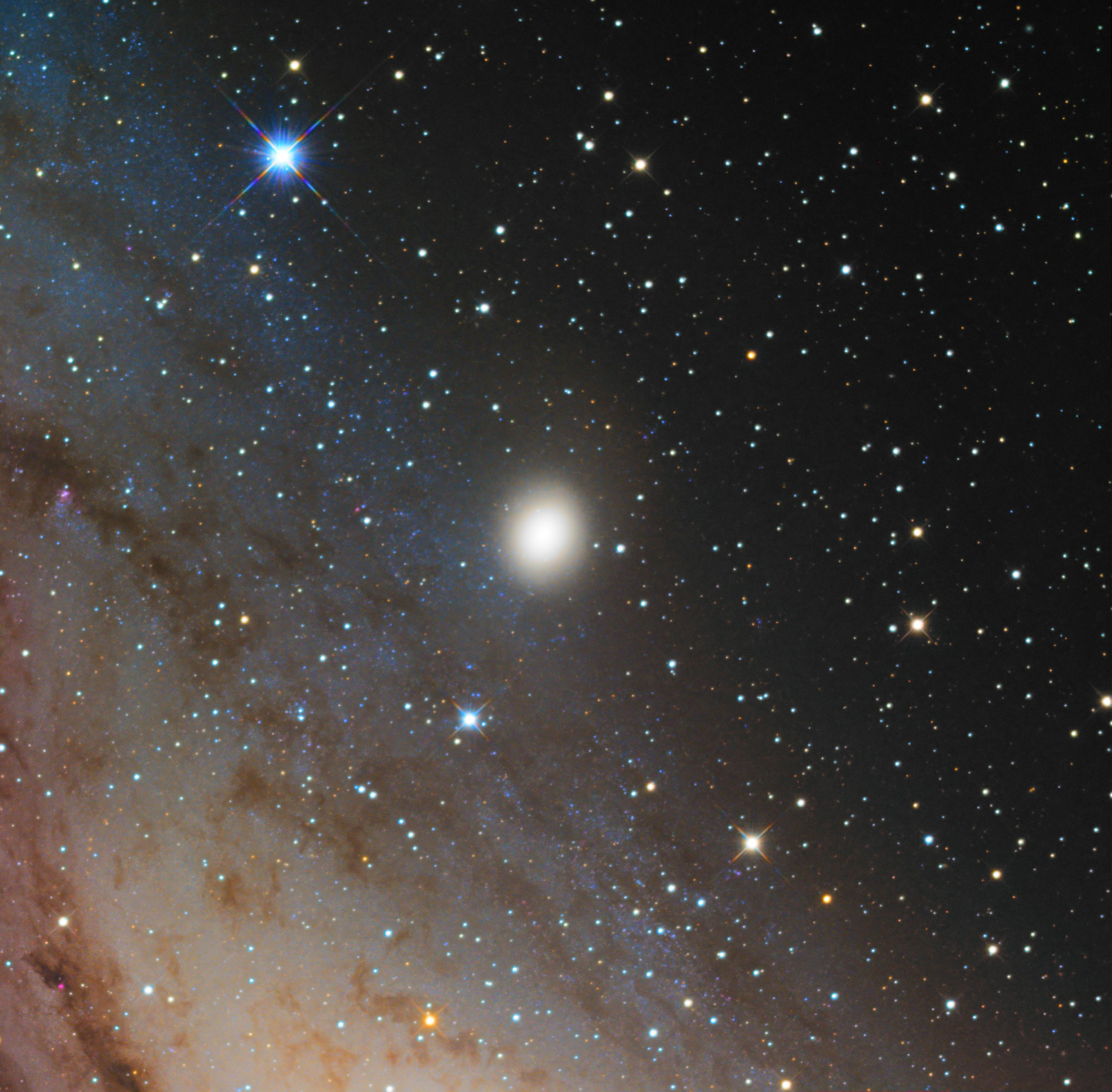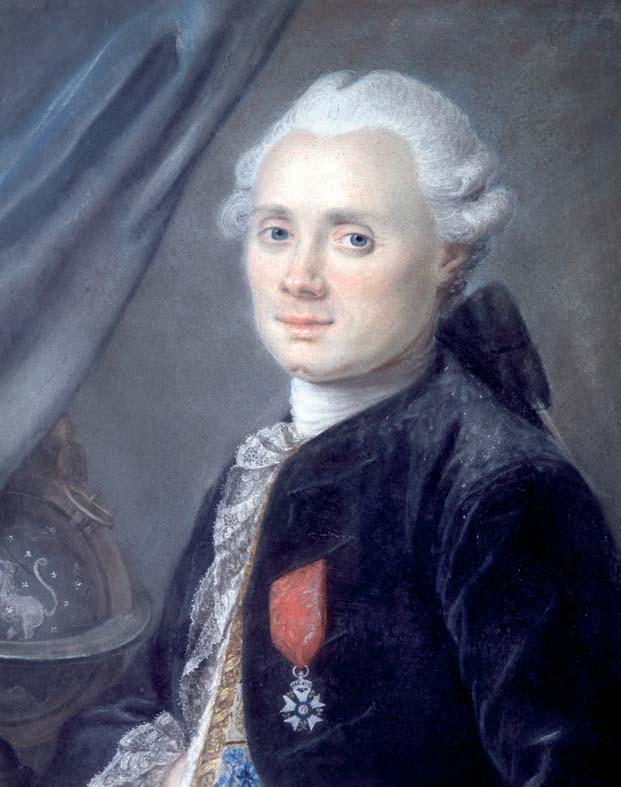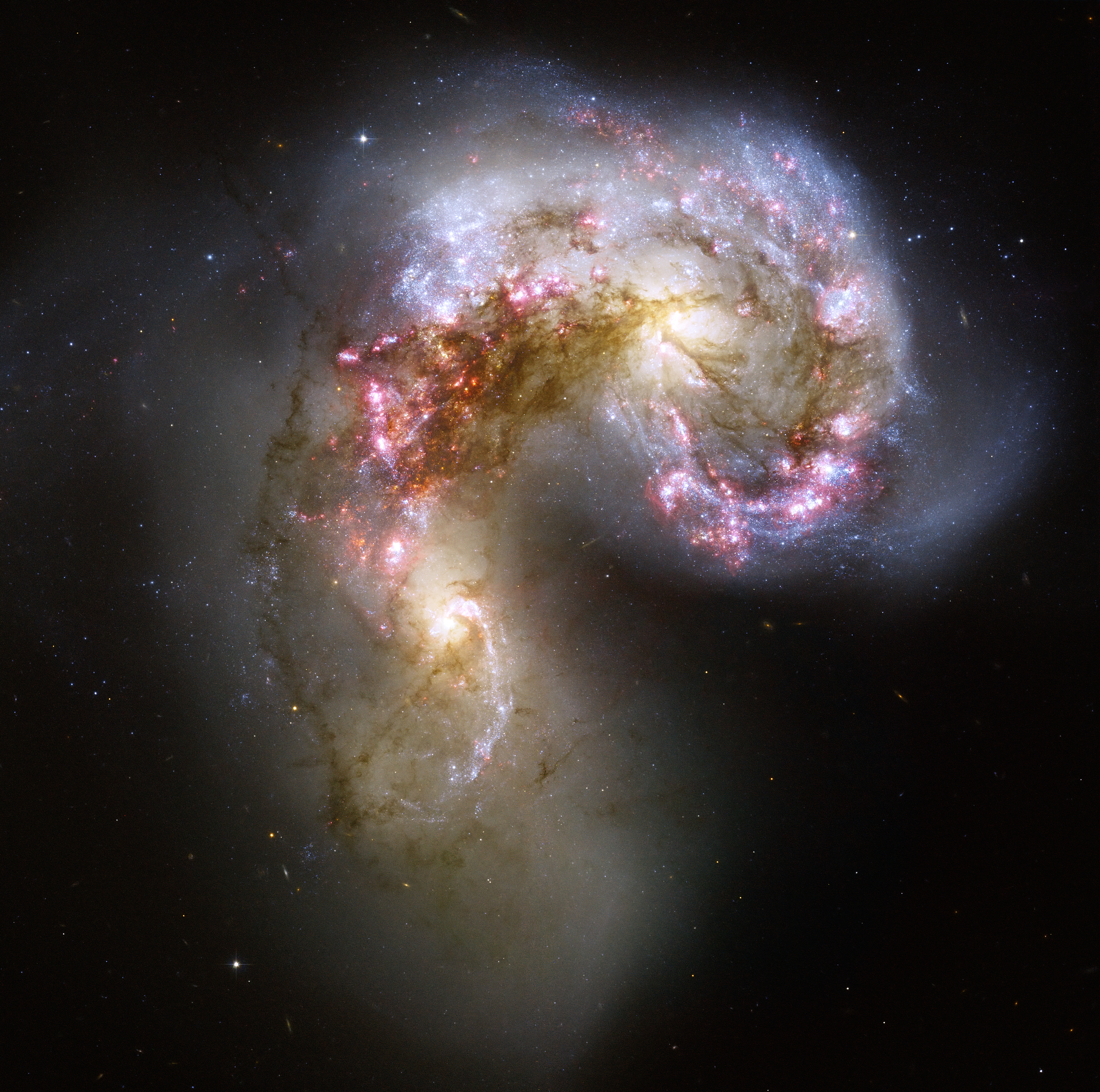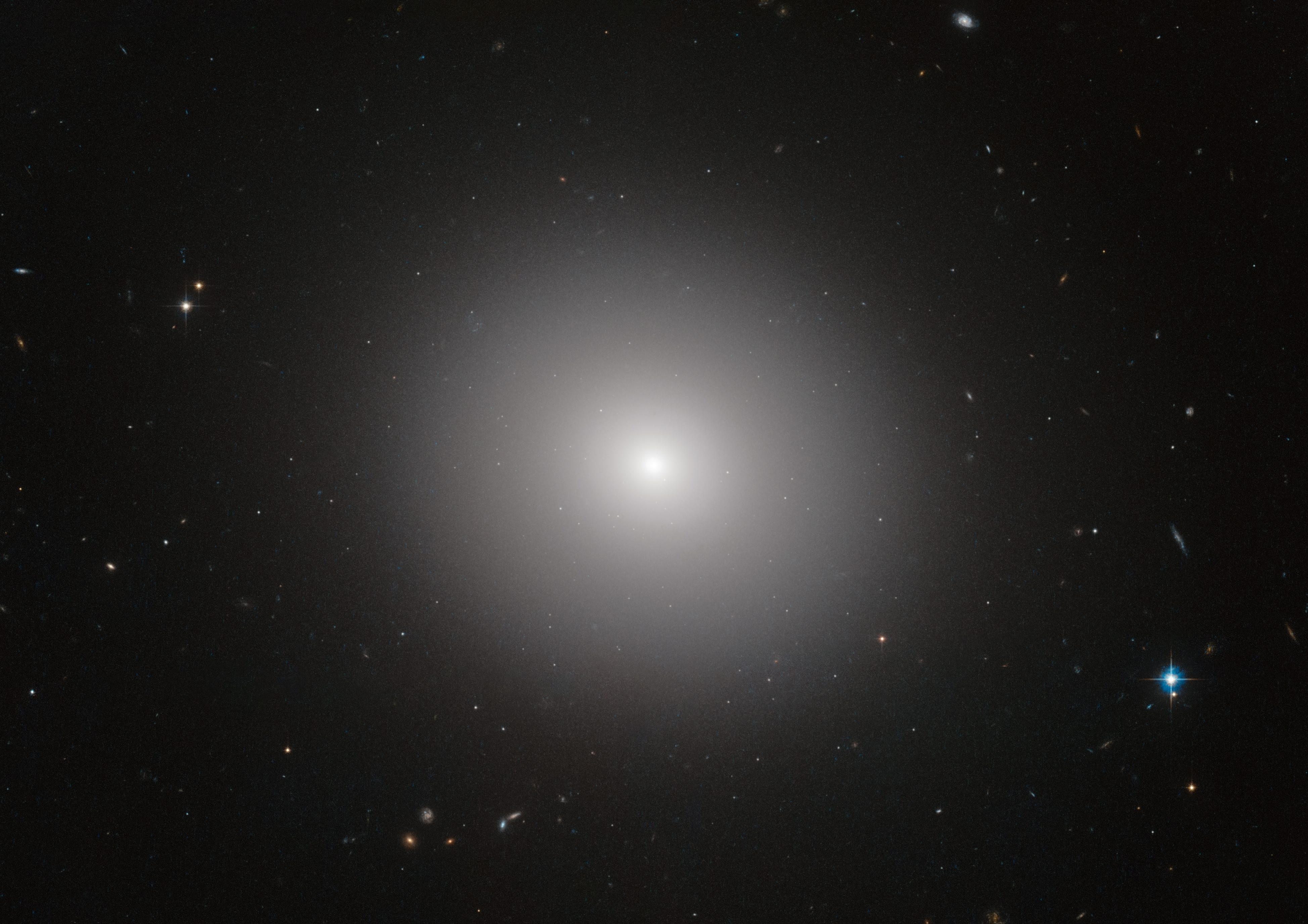|
Messier 32
Messier 32 (also known as M32 and NGC 221) is a dwarf "early-type" galaxy about from the Solar System, appearing in the constellation Andromeda (constellation), Andromeda. M32 is a satellite galaxy of the Andromeda Galaxy (M31) and was discovered by Guillaume Le Gentil in 1749. The galaxy is a prototype of the relatively rare compact elliptical (cE) class. Half the stars concentrate within inner core with an effective radius of . Densities in the central stellar cusp increase steeply, exceeding 3×107 (that is, 30 million) pc−3 (that is, per parsec cubed) at the smallest sub-radii resolved by Hubble Space Telescope, and the half-light radius of this central star cluster is around . Like more ordinary elliptical galaxies, M32 contains mostly old faint red and yellow stars with practically no dust or gas and consequently no current star formation. It does, however, show hints of star formation in the relatively recent past. Origins The structure and stellar content of ... [...More Info...] [...Related Items...] OR: [Wikipedia] [Google] [Baidu] |
Messier Object
The Messier objects are a set of 110 astronomical objects catalogued by the French astronomer Charles Messier in his ' (''Catalogue of Nebulae and Star Clusters''). Because Messier was interested only in finding comets, he created a list of those non-comet objects that frustrated his hunt for them. This list, which Messier created in collaboration with his assistant Pierre Méchain, is now known as the ''Messier catalogue''. The Messier catalogue is one of the most famous lists of astronomical objects, and many objects on the list are still referenced by their Messier numbers. The catalogue includes most of the astronomical deep-sky objects that can be easily observed from Earth's Northern Hemisphere; many Messier objects are popular targets for amateur astronomers. A preliminary version of the catalogue first appeared in 1774 in the ''Memoirs'' of the French Academy of Sciences for the year 1771. The first version of Messier's catalogue contained 45 objects, which ... [...More Info...] [...Related Items...] OR: [Wikipedia] [Google] [Baidu] |
Atlas Of Peculiar Galaxies
The ''Atlas of Peculiar Galaxies'' is a Astronomical catalog, catalog of peculiar galaxies produced by Halton Arp in 1966. A total of 338 galaxies are presented in the atlas, which was originally published in 1966 by the California Institute of Technology. The primary goal of the catalog was to present photographs of examples of the different kinds of peculiar structures found among galaxies. (online version, including Arp's original tabular data, and PDF link) Background Arp realized that the reason why galaxies formed into spiral galaxy, spiral or elliptical galaxy, elliptical shapes was not well understood. He perceived peculiar galaxies as small "experiments" that astronomers could use to understand the physical processes that distort spiral or elliptical galaxies. With this atlas, astronomers had a sample of peculiar galaxies that they could study in more detail. The atlas does not present a complete overview of every peculiar galaxy in the sky but instead provides exam ... [...More Info...] [...Related Items...] OR: [Wikipedia] [Google] [Baidu] |
M31 09-01-2011
M31 may refer to: Roadways * M31 motorway, a planned but unbuilt motorway in England * M-31 (Michigan highway), a former state highway in Michigan * Hume Highway in Australia, designated "M31" * M31 motorway (Hungary), a short motorway section near Budapest, Hungary * M31 (Cape Town), a Metropolitan Route in Cape Town, South Africa * M31 (Johannesburg), a Metropolitan Route in Johannesburg, South Africa * M31 (Pretoria), a Metropolitan Route in Pretoria, South Africa * M31 (Durban), a Metropolitan Route in Durban, South Africa Military * Suomi M-31 SMG, a Finnish WWII-era submachine gun * M31 HEAT rifle grenade * M31 Recovery Vehicle based on the M3 Lee tank * M31 rocket, an alternate designation for the MGR-1 Honest John, a United States military rocket * M31 (missile), for a multiple-launch rocket system (MLRS) * M31 is the pennant number for HMS ''Cattistock'', a Hunt-class mine countermeasures vessel Other * M31 = 0x7FFFFFFF = 2147483647, the eighth Mersenne prime ... [...More Info...] [...Related Items...] OR: [Wikipedia] [Google] [Baidu] |
The Astronomical Journal
''The Astronomical Journal'' (often abbreviated ''AJ'' in scientific papers and references) is a peer-reviewed monthly scientific journal owned by the American Astronomical Society (AAS) and currently published by IOP Publishing. It is one of the premier journals for astronomy in the world. Until 2008, the journal was published by the University of Chicago Press on behalf of the AAS. The reasons for the change to the IOP were given by the society as the desire of the University of Chicago Press to revise its financial arrangement and their plans to change from the particular software that had been developed in-house. The other two publications of the society, the ''Astrophysical Journal'' and its supplement series, followed in January 2009. The journal was established in 1849 by Benjamin A. Gould. It ceased publication in 1861 due to the American Civil War, but resumed in 1885. Between 1909 and 1941 the journal was edited in Albany, New York. In 1941, editor Benjamin Boss arranged ... [...More Info...] [...Related Items...] OR: [Wikipedia] [Google] [Baidu] |
Star Formation
Star formation is the process by which dense regions within molecular clouds in interstellar space—sometimes referred to as "stellar nurseries" or "star-forming regions"—Jeans instability, collapse and form stars. As a branch of astronomy, star formation includes the study of the interstellar medium (ISM) and giant molecular clouds (GMC) as precursors to the star formation process, and the study of protostars and young stellar objects as its immediate products. It is closely related to planet formation, another branch of astronomy. Star formation theory, as well as accounting for the formation of a single star, must also account for the statistics of binary stars and the initial mass function. Most stars do not form in isolation but as part of a group of stars referred as star clusters or stellar associations. First stars Star formation is divided into three groups called "Populations". Population III stars formed from primordial hydrogen after the Big Bang. These stars are ... [...More Info...] [...Related Items...] OR: [Wikipedia] [Google] [Baidu] |
Elliptical Galaxies
An elliptical galaxy is a type of galaxy with an approximately ellipsoidal shape and a smooth, nearly featureless image. They are one of the three main classes of galaxy described by Edwin Hubble in his Hubble sequence and 1936 work ''The Realm of the Nebulae'', with their intermediate scale disks, a subset of the "early-type" galaxy population. Most elliptical galaxies are composed of older, low-mass stars, with a sparse interstellar medium, and they tend to be surrounded by large numbers of globular clusters. Star formation activity in elliptical galaxies is typically minimal; they may, however, undergo brief periods of star formation when merging with other galaxies. Elliptical galaxies are believed to make up approximately 10–15% of galaxies in the Virgo Supercluster, and they are not the dominant type of galaxy in the universe overall. They are preferentially found close to the centers of galaxy clusters. Elliptical galaxies range in size from dwarf ellipticals with ... [...More Info...] [...Related Items...] OR: [Wikipedia] [Google] [Baidu] |
Hubble Space Telescope
The Hubble Space Telescope (HST or Hubble) is a space telescope that was launched into low Earth orbit in 1990 and remains in operation. It was not the Orbiting Solar Observatory, first space telescope, but it is one of the largest and most versatile, renowned as a vital research tool and as a public relations boon for astronomy. The Hubble Space Telescope is named after astronomer Edwin Hubble and is one of NASA's Great Observatories program, Great Observatories. The Space Telescope Science Institute (STScI) selects Hubble's targets and processes the resulting data, while the Goddard Space Flight Center (GSFC) controls the spacecraft. Hubble features a mirror, and its five main instruments observe in the ultraviolet, visible spectrum, visible, and near-infrared regions of the electromagnetic spectrum. Hubble's orbit outside the distortion of atmosphere of Earth, Earth's atmosphere allows it to capture extremely high-resolution images with substantially lower background lig ... [...More Info...] [...Related Items...] OR: [Wikipedia] [Google] [Baidu] |
Annual Review Of Astronomy And Astrophysics
The ''Annual Review of Astronomy and Astrophysics'' is an annual peer-reviewed scientific journal published by Annual Reviews. The co-editors are Ewine van Dishoeck and Robert C. Kennicutt. The journal reviews scientific literature pertaining to local and distant celestial entities throughout the observable universe, as well as cosmology, instrumentation, techniques, and the history of developments. It was established in 1963. As of 2023, it is being published as open access, under the Subscribe to Open model. History In November 1960, the board of directors of the nonprofit publisher Annual Reviews began investigating the need for a new journal of review articles that covered developments in astronomy and astrophysics. The board consulted an advisory group of experts, including Ronald Bracewell, Robert Jastrow, Joseph Kaplan, Paul Merrill, Otto Struve, and Harold Urey. The editorial committee met in August 1961 to determine the authors and topics for the first volume, ... [...More Info...] [...Related Items...] OR: [Wikipedia] [Google] [Baidu] |
Astronomical Journal
''The Astronomical Journal'' (often abbreviated ''AJ'' in scientific papers and references) is a peer-reviewed monthly scientific journal owned by the American Astronomical Society (AAS) and currently published by IOP Publishing. It is one of the premier journals for astronomy in the world. Until 2008, the journal was published by the University of Chicago Press on behalf of the AAS. The reasons for the change to the IOP were given by the society as the desire of the University of Chicago Press to revise its financial arrangement and their plans to change from the particular software that had been developed in-house. The other two publications of the society, the ''Astrophysical Journal'' and its supplement series, followed in January 2009. The journal was established in 1849 by Benjamin A. Gould. It ceased publication in 1861 due to the American Civil War, but resumed in 1885. Between 1909 and 1941 the journal was edited in Albany, New York. In 1941, editor Benjamin Boss arrange ... [...More Info...] [...Related Items...] OR: [Wikipedia] [Google] [Baidu] |
Effective Radius
In applied sciences, the equivalent radius (or mean radius) is the radius of a circle or sphere with the same perimeter, area, or volume of a non-circular or non-spherical object. The equivalent diameter (or mean diameter) (D) is twice the equivalent radius. Perimeter equivalent The perimeter of a circle of radius ''R'' is 2 \pi R. Given the perimeter of a non-circular object ''P'', one can calculate its perimeter-equivalent radius by setting :P = 2\pi R_\text or, alternatively: :R_\text = \frac For example, a square of side ''L'' has a perimeter of 4L. Setting that perimeter to be equal to that of a circle imply that :R_\text = \frac \approx 0.6366 L Applications: * US hat size is the circumference of the head, measured in inches, divided by pi (constant), pi, rounded to the nearest 1/8 inch. This corresponds to the 1D mean diameter. *Diameter at breast height is the circumference of tree trunk, measured at height of 4.5 feet, divided by pi. This corresponds to the 1D mean di ... [...More Info...] [...Related Items...] OR: [Wikipedia] [Google] [Baidu] |
Guillaume Le Gentil
Guillaume Joseph Hyacinthe Jean-Baptiste Le Gentil de la Galaisière (, 11 or 12 September 1725 – 22 October 1792) was a French astronomer who discovered several nebulae and was appointed to the Royal Academy of Sciences. He wrote on the estimation of the distance from the Earth to the Sun using solar transits, made unsuccessful attempts to observe the 1761 and 1769 transits of Venus from India during an 11-year journey from France, and wrote a popular account of his adventures and misadventures during the journey. Biography Guillaume Le Gentil was born on 11 or 12 September 1725 in Coutances and first intended to enter the church before turning to astronomy when inspired by a lecture by Joseph-Nicolas Delisle. By 1753 he was a professional astronomer and he wrote influentially on the subject of estimating the distance from the Earth to the Sun, the astronomical unit (AU), using transits of Mercury. He argued, contra Edmond Halley, that these transits could not be used f ... [...More Info...] [...Related Items...] OR: [Wikipedia] [Google] [Baidu] |






